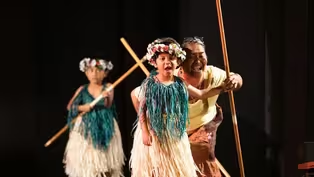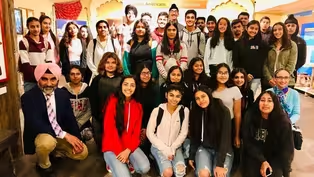KVIE Digital Studios
Akinsanya Kambon | Preserving Culture Through Art
7/2/2021 | 7m 5sVideo has Closed Captions
Artist Akinsanya Kambon hopes through his art to inspire others.
Artist Akinsanya Kambon hopes through his art to inspire others to seek truth and instill courage that inspires them to share their own stories through art.
Problems playing video? | Closed Captioning Feedback
Problems playing video? | Closed Captioning Feedback
KVIE Digital Studios is a local public television program presented by KVIE
Episode funded in part by the California Arts Council, a state agency.
KVIE Digital Studios
Akinsanya Kambon | Preserving Culture Through Art
7/2/2021 | 7m 5sVideo has Closed Captions
Artist Akinsanya Kambon hopes through his art to inspire others to seek truth and instill courage that inspires them to share their own stories through art.
Problems playing video? | Closed Captioning Feedback
How to Watch KVIE Digital Studios
KVIE Digital Studios is available to stream on pbs.org and the free PBS App, available on iPhone, Apple TV, Android TV, Android smartphones, Amazon Fire TV, Amazon Fire Tablet, Roku, Samsung Smart TV, and Vizio.
Providing Support for PBS.org
Learn Moreabout PBS online sponsorshipMore from This Collection
Discover how the Punjabi American Heritage Society is using art as a resource in helping build connection, while gaining understanding and preserving culture.
Pamela J. Peters | Preserving Culture Through Art
Video has Closed Captions
Multimedia Artist Pamela J Peters describes her work as Indigenous Realism. (6m 42s)
TeAda Productions | Preserving Culture Through Art
Video has Closed Captions
TeAda Productions extends an outlet of service, education and creative courage. (6m 8s)
Artist Dr. Monica Crooks | Preserving Culture Through Art
Video has Closed Captions
Meet artist and dentist Dr. Monica Crooks. (6m 4s)
Punjabi American Heritage Society
Video has Closed Captions
See how the Punjabi American Heritage Society is preserving culture through art. (5m 8s)
Providing Support for PBS.org
Learn Moreabout PBS online sponsorship♪♪ Akinsanya: I like to have people walk through and they're looking.
If there's music playing by a particular piece, you can feel that the drum beat.
And when you look at the work, you feel like you're right there in the painting or in, right in the sculpture, you can, you can kind of connect with the spirit of whatever it is... ♪♪ ...
I think that I would like people to know that I don't look at it as my art.
I look at it as the people's art.
I think that it came through me and I felt like I was just used as a vehicle to create this... you know, when I'm creating.
Uh, I guess people that are around me, they know that I'm in the trance.
I'm not even present mentally.
I'm like in a spiritual place.
And, uh, like the ancestors told me we have been guiding your hands.
So they guide, they guide my hands.
I think art is the most vital thing is something special because you can see it, you can touch it, you can feel it... art is one of most important and one of the best ways of expressing one's culture because, uh, people's culture is like a total of everything that they do.
It's the history, the talk, the dance, the songs, and the way you express all of that, how you tell the story, is you tell the story with the art.
So that people that come after us can look at the art and learn to read it... Marinda: As a former Marine, art professor and member of the Black Panthers, Akinsanya believes that his art preserves the foundation of the past.
And in order to create change for the next generations, we must start by acknowledging the shame of that past.
Akinsanya: And I look at it from that position.
I just can't help it because you know of these things, you know, and you see that this hatred is something that could have been dealt with after the civil war, but it wasn't.
It was something that they, they let all the captive, uh, Confederate soldiers go home after the war, they let them out of prison.
And when they got home.
They had this in their mind that there's a such thing as the superior race.
They didn't do anything to reeducate them.
You know, and make them look at all people as though we are all humans, they still look at us as thou we are inferior and they feel like they have the right to rule us and they see us as a threat.
And that pains me.
So I know that the artwork that I do will be teaching about this struggle long after I'm dead, it will be teaching.
And I'm glad of that.
...when I was in the black Panther party, um, I was the Lieutenant of culture for the Sacramento chapter.
And my responsibility was to interpret everything that came out.
Uh, in a revolutionary way to kind of bring about change...
I think that you should allow young people to ask questions and you can't just give them an answer that you believe you gotta, you gotta kind of find out what the truth is.
Marinda: When you experience the works of Professor Akinsanya Kambon, you learn from, engage with, and are inspired by his art.
With over 4000 works, Akinsanya hopes to instill courage in others to seek truth and share their own stories.
While also ensuring his art is accessible to everyone.
Akinsanya: And I think that I need to try and make it available to young people, to all the youth, black, white, red, yellow, it doesn't matter...
I think that all youth should be exposed to it so they can all learn.
It gives a child hope they can see things.
That, whatever artists did the work, they can see it.
They can look at it.
I mean, I still remember the paintings and the horses and the dogs and all the little things that the artists did and how the paintings were like huge.
And to see all of that as a child, I think it just gave me a world.
It makes you want to live.
It makes you want to do things.
It makes you want to go places.
It makes you want to learn.
And I think that's what kind of started me on a journey.
And I really, uh, have a lot of respect for my wife because she stuck in there through everything I went through and she's responsible for me being alive right now.
You know, so I think that was a spiritual connection too, I believe.
For me, art is life.
It's like air it's like everything you need to survive.
I couldn't survive without it.
Um, I think that, um, I think I was kept alive to do what I'm doing.
I mean, I, I was blown up twice in Vietnam.
I could have been dead either one of those times, I got shrapnel steel coming out of me sometimes, you know.
And, um, I, uh, I think about all the different times I could have lost my life and didn't, and I look at it like it's a blessing from the creator and when he's tired of me doing the work that I'm doing.
He let me come on home to heaven and wherever, or wherever I'm going, you know, so I don't worry about it.
I just, um, I just I'm blessed to be here, you know.
I'm blessed to do the work that I do.
♪♪
Support for PBS provided by:
KVIE Digital Studios is a local public television program presented by KVIE
Episode funded in part by the California Arts Council, a state agency.

















